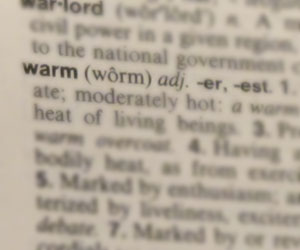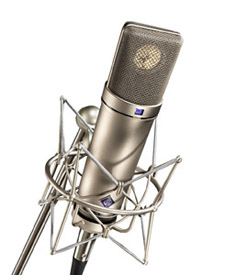Dancing About Architecture: A Dictionary of Audio Terms
In issue #83 of my other favorite magazine, Tape Op editor Larry Crane details a list of lessons that “They Didn’t Teach You in [Recording] School”. Near the end of this page-long list of incisive barbs Crane offers a quip that reads as a gem of painfully dry studio wit:
“Words like ‘warm’ and ‘punchy’ will drive you crazy,” he writes, “as they do not mean anything.”
We’ve all been there: sitting in the studio trying to get our messages across in clumsy and intuitive terms. But musicians and engineers often speak different languages. So how can we have productive conversations about the ineffable?
This isn’t an obstacle relegated to novices in small studios. In the film Eating, Sleeping, Waiting, and Playing, Justin Meldal-Johnsen (Bassist for Beck, Gnarles Barkley, Garbage, NIN, Macy Gray) fondly recalls nebulous directives from the French band Air.
“On this song,” they might say, “the bass should sound as if it is a beautiful carpet.”
Although I’d hate to live in a world without endearingly unwieldy descriptors like that one, there are times when a little more clarity can help. To that end, we offer this brief dictionary of audio terms.
Punchy [adj \’pən-chē\]
Just how can a sound be “punchy” anyway? Merriam Webster defines this quality as “forceful, spirited, vivid, vibrant”. That sounds nice enough, but like many general definitions, it leaves us with a moving target.
One widely attributed audio glossary gives us the definition “Good reproduction of dynamics. Good transient response, with strong impact.”
But, a similar glossary on Talk Bass has a different take on the term: “Strong lows/mids that produce a pronounced dull initial attack – muted/padded kick drum-like in character”.
Both definitions sound serviceable enough, but they contradict each other. “So,” you might ask, “which is it?”
In truth, “punchy” is such a slippery term because it doesn’t describe a single characteristic; Instead, it suggests a balance between a few. In common use, a “punchy” sound is usually one that has a solid, meaty impact delivered with weight and substance – but it’s also a sound that has a clear and definitive attack.
If that’s the case, it is perfectly reasonable for a person to say “I like that snare sound, it’s full and punchy,” or its converse: “I like that snare sound, it’s clear and punchy”. The real problem arises when we make directive statements: “I want the sound to be more punchy.” This rarely works.
Whenever we need to give directions in tweaking a sound, it’s time to abandon wishy-washy words that suggest balance. It’s time to embrace directive terms that point us in a clear direction.
We can ask for a snare drum to be more full or more clear and have a reasonable expectation of being understood. But punchier? Punchier how?
Better words:
The English language gives us thousands of adjectives that we can borrow to describe sounds. Why settle for an unclear one? Some of the best words available are open to interpretation, but as a starting point they can also be nearly onomatopoeiac in their accuracy.
It’s perfectly acceptable to ask for a sound with more crack, thud, zing or sizzle. How about one that’s pocky or snappy? What about a sound that’s deeper or sharper?
These might not be absolute terms, and they may frustrate the most stodgy and disagreeable of engineers (what won’t?), but words like these can still help us steer our tones in the right general direction.
As for “punchy”, a sloppy word that describes an unsloppy sound, perhaps it’s best defined by omission – what’s not punchy? A pillow isn’t. But neither is a glockenspiel.
A slab of deeply-chilled T-bone being pummeled by the hammer from a carnival high striker? Now we’re getting somewhere.
Here’s a definition that works for us, even if it’s a general one: “Punchy : A sound characterized by its full, even, and robust attack.”
Warm [adj \wawrm\]
For years, this single word has been one of the biggest offenders in the lexicon of sound. Once on the lips of every neophyte audiophile, the word “warm” is now looked upon with the kind of disdain normally reserved for the worst racial epithets.
But just what does it mean? One of the problems with the word is that its definition is quite literally “anything you like”. According to mainstream dictionaries, when used as a verb, it means “To fill with pleasant emotions” or “to infuse with a feeling of love, friendship, well-being, or pleasure”.
Wow. When it comes to pleasure, it takes all kinds. No wonder this term has taken on all kinds of meanings.
J. Gordon Holt at least tries to narrow it down in “Sounds Like? An Audio Glossary”. Here he gives us “Warmth: A listening term. The opposite of cool or cold. In terms of frequency, generally considered the range from approx. 150Hz-400Hz.”
150Hz-400Hz? At least that’s something concrete. Refined listeners would tend to agree, if not on those numbers, at least that “warmth” is characterized by an ample serving of low-to-low-mid frequencies. But like punchiness, warmth connotes balances. A warm sound is a thick and full-bodied one, yes – But it rings with enough clarity and articulation to keep us from calling it “murky” instead.
On top of all that, warmth also suggests a sound rich in even-order harmonics, and a tone that lacks the nakedly disproportionate transients associated with early digital formats.
Better words:
As descriptor, the word warm has been used and misused so often that it ceases to mean anything. This engineer has even heard it used as a substitute for “bright” (trebly). How’s that for creating confusion?
As a direction, “warmer” only works in a game of Marco Polo. In the studio, inventive textural terms are more easily understood. How about going for a sound that’s a shade more muddy, murky, woody, or woolly? A tone that’s poking us in the ear might want to be more hazy, veiled, or softer-around-the-edges.
If we go too far into mushville we can always be asked to reel it in by going for more articulation, clarity, snap, or precision. And if we forgot to add some tasteful harmonic and dynamic distortion, we can always go for some more cream, edge, bite, or hair.
Once again, omission might get us a little closer to the meaning: What’s not warm? Any record by The Smiths. Kanye West’s discography and/or personality, D-Verb. What is? Led Zeppelin III, Kind Of Blue, a good recording of Peter and The Wolf, any mid-century crooner recorded at Ocean Way Studios.
When Less is More
Sometimes, when we’re grasping for just the right description, we forget that the simplest terms are often the best. Whatever happened to dark and bright?
As far as audio terms go, they’re probably the most powerful and flexible words in the dictionary – the hammer and screwdriver of audio conversation. Don’t think for a minute that relying heavily on these two terms makes you sound like a simpleton. Using these words shows more class than Clark Gable carrying your grandma’s groceries across the street.
Brighter: More treble please. Darker: Less, thank you. Like wet/dry, longer/shorter, or faster/slower, these are words that clarify our thinking by forcing us to focus on one dimension at a time.
Surprisingly enough, even words this simple are sometimes misused, or confused, or just disagreed on.
In March, Matt McGlynn and the team at Recording Hacks produced a brief video shootout between a vintage Neumann U87i and its contemporary equivalent, the U87ai.
In test after test, the mics performed as expected: the newer U87ai version required less gain, offered marginally lower self-noise, and provided measurably higher levels of upper-midrange and high-frequencies than the vintage version. Yet somehow, a panel of 4 listeners, ostensibly professionals, was split on which whether to call the vintage U87 “brighter” or “darker”.
I’ll keep quiet about my own hot-blooded internal reactions toward the half of the panel who I felt were clearly in the “wrong”. The truth is that similar sounds can even be heard differently due to individual variations in physiology, listening ability, or subjective experience.
Perhaps the best lesson that we can learn from this panel is not in which mic is brighter than the other – it’s in the civility they maintained while disagreeing over the most basic questions about sound.
This panel reminds us that an audio dictionary is best used like a real one. There are few benefits in hammering adversaries over the head with our superior knowledge of verbal minutea, or in sprinkling our conversations with pompous 10-cent words. (And this is coming from a guy who just used “ostensibly” in a sentence).
Dictionaries serve us best when they help us understand each other, ideally fostering conversations that lead somewhere.
Of course lovers of words can sometimes get a little carried away. Holt’s audio glossary for instance, includes terms as wacky and esoteric as “Plastery – A hard-sounding reverberation having an “a” (as in “cat”) coloration, characteristic of bare, plaster-walled rooms.”
I’m not sure if I’ll ever use the word in conversation, but I sure can’t get it out of my head.
Whenever we do go overboard with discussion, I try to remember a definition Ingrid Bergman gives us: “A kiss is a lovely trick designed by nature to stop speech when words become superfluous.” In the studio, the same can be said for music.
What do you think? Do we need a dictionary of audio terms? Which ones do you feel are most commonly misunderstood? Do you have a favorite word or definition to share? Let us know in the comments section below.
Justin Colletti is a Brooklyn-based producer/engineer who works with uncommon artists, and a journalist who writes about music and how we make it. Visit him at http://www.justincolletti.com.









